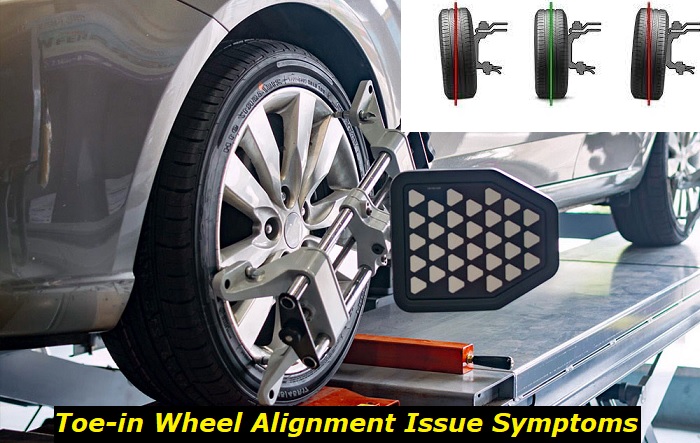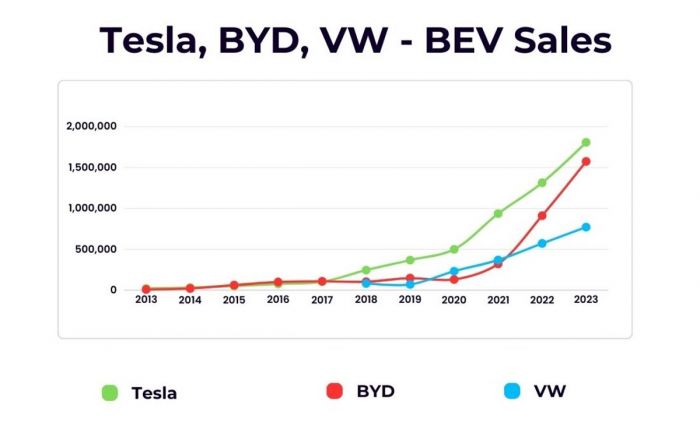Some car terms and words are so complicated that drivers just can't remember what they mean and how to interpret them when a mechanic keeps firing these words like crazy. Before we start this article, we should understand what "toe" is in cars.
Wheel alignment problems highlights
- Level of importance:medium
- Commonreasons:hitting a curb, potholes, suspension problem, suspension repair
- DIY inspection:impossible
- DIY repair:impossible
- Average price in shops:$150 - $250
- Average time:0.5 - 1 hours
- If ignored:safety issues, tire wear, problems with steering

Toe-in - main symptoms you may notice in your vehicle
Before we move on to talk about the consequences and some important considerations of the toe-in issue, let's first talk about the symptoms of this problem. So, now you know that the toe-in problem is when the wheels on your car are pointed toward each other in the front part. It means that the wheel alignment is not completely OK and the car may do several nasty things on the road.
Also, remember that the symptoms may come altogether or one by one and their intensity depends really much on the scale of the problem. The worse the alignment is changed, the more noticeable the symptoms are.
Here are the most common symptoms of toe-in in your car:
- Poor handling. You need to control the steering wheel all the time and once you let it go, the car goes to one of the sides.
- The braking effect when driving. When your car is in neutral or you let go the gas pedal when driving, your vehicle with a toe-in issue will brake unintentionally.
- Poor gas mileage. This problem comes from the previous one. When the vehicle is constantly braking, you will lose some fuel efficiency.
- Uneven tire wear. If you drive a lot this way, you can lose your tires. The toe-in issue makes the tire contact the road not with the whole surface but with the outer part of the tire which causes extensive wear.
- Vibration at higher speed. Bad alignment causes vibration at speeds over 50 MPH. The faster you go, the more noticeable the vibrations are.
- Bad stabilization after you turn. In severe issues, the car may feel hard to stabilize after a sharp turn. It means you will always experience problems with safe handling.
Now you know the most common symptoms of the toe-in issue. But keep in mind that it's not necessary that all symptoms should be there in your car. Even if one or two bullets of this list are true for your vehicle, you should worry and have the alignment checked in a repair shop that has the equipment for this.
Addressing the issue right when you notice it is very important. We know quite a lot of cases when people got into road accidents because of bad wheel alignment. This is an important part of the safety of your vehicle.
What are the reasons for the toe-in problem?
The toe-in issue happens because of the bad wheel alignment. There are special adjustment bolts in the suspension of your vehicle that are aimed to allow a mechanic to align the wheels properly. After a year or two of your driving, wheel alignment may go from ideal parameters to the red zone and this will give a start to all those symptoms.
It's recommended by most car manufacturers to have your wheel properly aligned at least once every 3 years. But we believe these recommendations are too optimistic. Maybe, if you drive on perfect roads and never get in potholes, you may actually have the wheels aligned every three years only.
But here are some of the reasons why toe-in may go wrong:
- Potholes. The most common reason is going into road pits. When your suspension gets some stress, the wheel alignment may change a little. The more you drive on bad roads, the worse the situation gets.
- Just time. Over time, the suspension gets enough stress even on good roads to have the wheel alignment changed. One time you hit the curb with the wheel, then you drive aggressively. Everything leaves its own mark on the suspension.
- Suspension and steering system repairs. When you change some parts of your suspension, it's very likely that wheel alignment will not be the same. You should check it after each repair.
- Change of tires. Old tires may wear in a certain way and be OK with the current wheel alignment. But once you get brand-new tires, the situation may get much worse. Wheel alignment with new tires is badly recommended.
- Any road accidents. If your vehicle was in an accident, you should check the wheel alignment after you repair everything else. This is an important part of proper care (or TLC) and a safety measure.
- Bad suspension parts. If the struts or shock absorbers are worn out, the vehicle may show different wheel alignment figures every time you check it. Good suspension is the key to success, in this case.
- Bad body repair. If you constantly have problems with toe-in, check whether the vehicle was repaired after an accident with front-end damage. Changed and poorly repaired body geometry will create a lot of problems with wheel alignment.
Now you know all the major reasons for bad toe-in and why it may happen in your vehicle. In most cases, this is just a minor issue that needs a quick readjustment of the suspension system with a simple procedure. But sometimes, other repairs are needed if your body lost the proper geometry or one of the suspension parts is bad.
There are different optimal parameters for toe-in in various vehicles, so you should let professionals check this. They have the needed information in their computers and they know for sure how to align the wheels to let you drive with zero problems.
Can you adjust toe-in by yourself?
Potentially, you can adjust the wheels by yourself but we strongly recommend a proper professional service for this. Using your sharp eye is probably the worst way to understand if your vehicle has a toe-in issue. Also, the human eye will never help in adjusting this parameter.
Although you can easily locate the toe-caster bolts in your suspension, we don't recommend touching them with your tools. You may actually make things much worse. Also, poorly tightened bolts may easily be the reason for a road accident.
For proper adjustments, professionals use sensitive equipment with laser sensors that they mount on each wheel. And then the computer takes the optimal parameters for your vehicle and compares them with the parameters from the sensors. After that, the mechanic can adjust the wheels the proper way.
Making all these steps in your garage is just impossible because you don't have the needed equipment and tools for this.
How long can you drive with toe-in problems?
The safety of your driving may be questioned if you drive with a toe-in problem. This depends on how much the alignment is changed. If you can see with your naked eye that the wheel is mounted in an improper way, it's better to avoid driving at all. But in most cases, you can still drive a couple of miles to find the repair shop with the needed equipment.
Here's what you should do to ensure you are safe on the road:
- look at the wheels and identify if they are OK, they shouldn't look crooked or something;
- drive your vehicle very slowly - up to 15-20 MPH;
- take the right side of the road;
- turn on the emergency light to warn other drivers;
- keep your steering wheel in your hands firmly.
The best strategy, in this case, is to get the car directly to the repair shop that can help you with wheel alignment. You can go to one of the dealers - they will obviously have the needed equipment and expertise to do this job.
But first of all, you need to ensure that driving is safe. We don't recommend driving the vehicle if the wheels don't look straight, the tire is completely worn on one side, and the steering and handling became impossibly unpredictable. These are the signs that you should better call a tow truck and pay some extra money for your safety.
About the authors
The CarAraC research team is composed of seasoned auto mechanics and automotive industry professionals, including individuals with advanced degrees and certifications in their field. Our team members boast prestigious credentials, reflecting their extensive knowledge and skills. These qualifications include: IMI: Institute of the Motor Industry, ASE-Certified Master Automobile Technicians; Coventry University, Graduate of MA in Automotive Journalism; Politecnico di Torino, Italy, MS Automotive Engineering; Ss. Cyril and Methodius University in Skopje, Mechanical University in Skopje; TOC Automotive College; DHA Suffa University, Department of Mechanical Engineering






Add comment